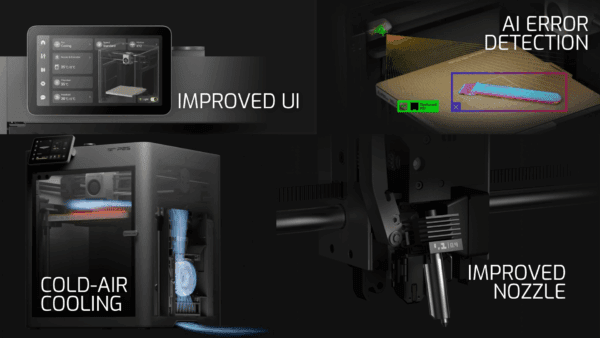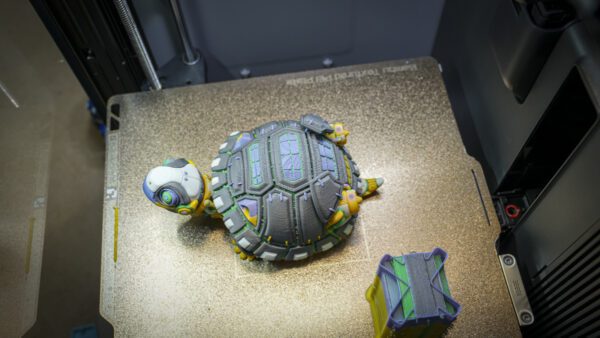Introduction
If you’re active in the 3D-printing world, then the arrival of the Bambu Lab P2S is something to pay attention to. Bambu Lab has taken their widely appreciated P1-series and “re-engineered” it for 2025, aiming to impress across speed, precision, usability and material flexibility. Bambu Lab Blog
In this blog we’ll be unpacking what the P2S offers, what makes it special from a practical/hobbyist point of view, and finally the things to watch out for.
What the P2S brings to the table
Here are some of the key highlights of the P2S:
Core specs & build
-
Build volume: 256 × 256 × 256 mm — same as previous P-series. Tom’s Hardware
-
Direct-drive extruder with a hardened steel 0.4 mm nozzle. Tom’s Hardware
-
Full enclosure (important for higher-temperature materials, though PLA gets by easily) and a refined Active Airflow system to manage chamber conditions. Bambu Lab Blog
-
New quick-swap nozzle mechanism (magnetic / buckle style) taken from the H-series lineage. Tom’s Hardware
-
Improved UI: 5-inch colour touchscreen, improved camera monitoring, AI error detection. — Ask and Bambu Lab will Provide! Bambu Lab Blog
-
Connectivity: USB, WiFi, Bluetooth. Tom’s Hardware

What’s new / improved over the P1S
The P2S is pitched as an evolution of the P1S. Some of the improvements include:
-
Upgraded nozzle system and extruder flow capability. Tom’s Hardware
-
Better airflow / chamber conditions (Active Airflow) for more consistent prints. Bambu Lab Blog
-
Enhanced UI + monitoring features (more refined camera, AI error detection). TechRadar
-
Still the same build-volume footprint (so desk-friendly) but with more capable internals. All3DP
Print quality & reliability

Reviews so far have been very positive:
-
On accuracy: one review recorded XY error average around 0.15mm for a 25mm target — quite strong. TechRadar
-
On reliability and usability: labeled by TechRadar as “a no-fuss option … for any classroom, business or workshop” thanks to finish and ease-of-use. TechRadar
-
One article: “The P2S maintains Bambu Lab’s exceptional level of speed, quality, and ease of use … making it one of the best 3D printers we’ve seen this year.” Tom’s Hardware
If you’re printing PLA in your workshop/hobby context, this machine appears to bring both performance and convenience — which is a strong combination for a user who already knows 3D printing bugs and setup hassles.
Why this matters for you

Whether you work in manufacturing or a hobbyist, and you’re in the Philippines — here’s how the P2S could align with your workflow and environment:
-
Speed + quality: If you’re iterating designs (for product development or prototyping), the faster and reliable machine helps reduce downtime.
-
Ease of use: The improved UI, camera monitoring and built-in reliability reduce the “printer babysitting” time — freeing you to focus on design rather than fiddling with hardware.
-
Material flexibility: While you currently focus on PLA, the P2S’s enclosure and features mean you can more readily experiment with TPU, ABS, etc if your hobby takes you there.
-
Print-farm potential: If you ever consider a small print-farm, P2S is a good budget machine paired with consistent speed and quality— an advantage when scaling beyond one machine.
Points to consider
No printer is perfect, and the P2S has some caveats to keep in mind:
-
Waste with multi-material/multi-colour: Some reviews emphasise that when using the AMS (Automatic Material System) for multi-colour printing, there is still non-trivial waste (purge of old filament etc). TechRadar
-
Closed (proprietary) ecosystem: As with many machines from Bambu Lab, there’s some reliance on their software/firmware ecosystem. If you’re deeply into custom slicers or open-source workflows, check compatibility. The company’s user base has flagged this for earlier machines. Bambu Lab Forum
-
Farm / 24-7 usage unknowns: If you plan heavy continuous usage (print farm, 24×7), long-term reliability data is still building. Some users for earlier P1S models wonder how many hours they’ll get. Bambu Lab Forum
-
Material cost / support: For hobbyists using PLA, this is fine, but if you scale up or use high-performance materials, ensure local filament supply, maintenance parts etc are ready in the Philippines. Good thing Puzzlebox 3D comes comeplete with support and engineering materials!
Final Thoughts
The Bambu Lab P2S is a strong contender for a high-performance, user-friendly, production-capable 3D printer in the mid-to-premium range. If you’re upgrading from consumer machines or building a small print farm (or iterating product prototypes), it makes a lot of sense.
Since you focus on PLA printing, the machine will definitely give you faster prints, higher quality, and less hassle. And it gives you headroom to move into tougher materials later if needed.
If I were to give a recommendation:
-
If budget allows → go for the P2S for a future-capable 3D printer
-
If you’re a beginner with hopes of trying high-performing materials in the future → P2S should be perfect for you
- The new Bambu Lab P2S is the perfect middle ground between budget and performance
Check out the New Bambu Lab H2S: Bambu Lab H2S: The Powerful 3D Printer Changing the Game
Check out other Bambu Lab Products: Bambu Lab Philippines Official Distributor – Puzzlebox 3D Solutions
